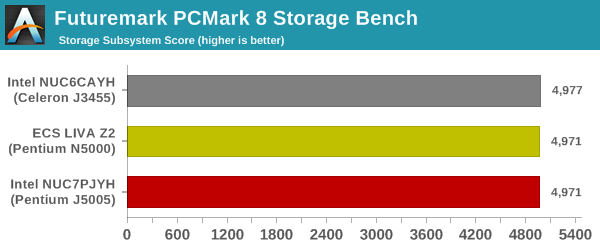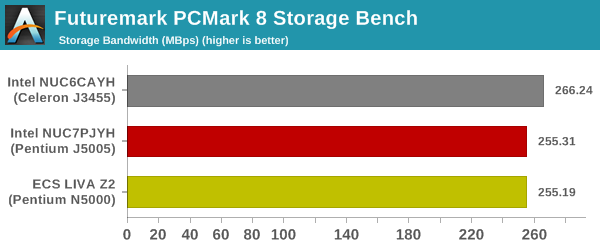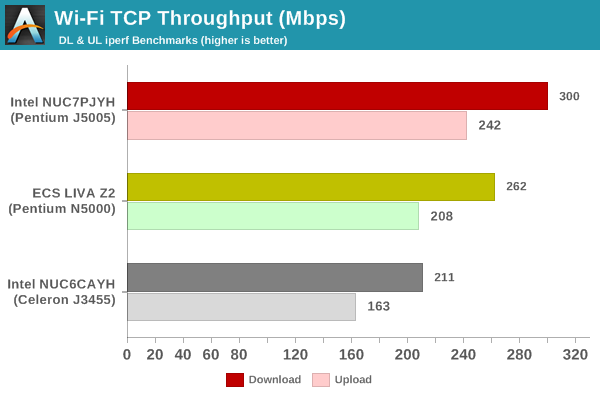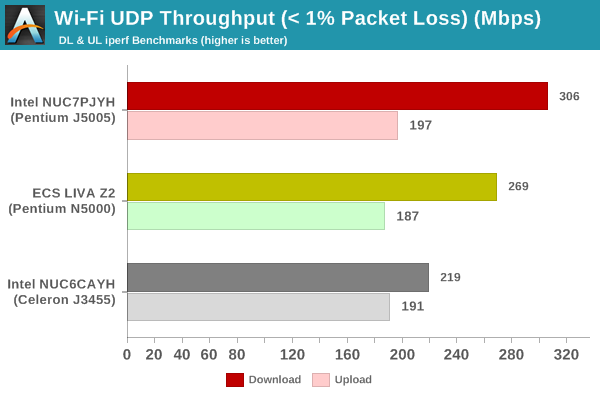Gemini Lake SFF PC Showdown: Intel's June Canyon (NUC7PJYH) and ECS's LIVA Z2 Reviewed
by Ganesh T S on December 20, 2018 8:00 AM ESTNetworking and Storage Performance
Networking and storage are two major aspects which influence our experience with any computing system. This section presents results from our evaluation of these aspects in the Intel NUC7PJYH. On the storage side, one option would be repetition of our strenuous SSD review tests on the drive(s) in the PC. Fortunately, to avoid that overkill, PCMark 8 has a storage bench where certain common workloads such as loading games and document processing are replayed on the target drive. Results are presented in two forms, one being a benchmark number and the other, a bandwidth figure. We ran the PCMark 8 storage bench on selected PCs and the results are presented below.


There is really not much to choose from between the three systems - our choice of storage drives (Crucial BX300) was the same for both the Gemini Lake units, and that is reflected in the above graphs.
On the networking side, we restricted ourselves to the evaluation of the WLAN component. Our standard test router is the Netgear R7000 Nighthawk configured with both 2.4 GHz and 5 GHz networks. The router is placed approximately 20 ft. away, separated by a drywall (as in a typical US building). A wired client is connected to the R7000 and serves as one endpoint for iperf evaluation. The PC under test is made to connect to either the 5 GHz (preferred) or 2.4 GHz SSID and iperf tests are conducted for both TCP and UDP transfers. It is ensured that the PC under test is the only wireless client for the Netgear R7000. We evaluate total throughput for up to 32 simultaneous TCP connections using iperf and present the highest number in the graph below.

In the UDP case, we try to transfer data at the highest rate possible for which we get less than 1% packet loss.

Despite all the WLAN modules being 1x1, the June Canyon NUC has much better numbers. In part, this is due to the availability of antenna diversity in the AC 9462 (which allows the better of two antennae to be utilized for communication).










59 Comments
View All Comments
DigitalFreak - Thursday, December 20, 2018 - link
What does it say about Intel Ethernet controller pricing when they use a 3rd party one on their own system?JoeyJoJo123 - Thursday, December 20, 2018 - link
I was going to ask about that.I don't want to come across as "realtek ethernet BAD", but the reality is that for FreeBSD OS, Intel LAN drivers are more mature and have generally better performance. You'd think Intel would use an in-house ethernet controller for their in-house NUC, but they went with Realtek...
Is there a particular reason to go with a Realtek controller in an Intel product? Or is it really just a cost-cutting measure?
HStewart - Thursday, December 20, 2018 - link
It probably a factor that this is Pentium CPU and chipset does not support it on low end - but they wanted to add it.Hixbot - Thursday, December 20, 2018 - link
Any reason a "Top Five Black Friday Tips" video has to cover half the page?mode_13h - Friday, December 21, 2018 - link
Maybe because you're monitor is too small.:-]
mode_13h - Friday, December 21, 2018 - link
Gah, your.Hixbot - Tuesday, January 1, 2019 - link
It's a phone so yea. My question was directed to the web design team.dj_miggy - Thursday, January 3, 2019 - link
LOLzepi - Friday, December 21, 2018 - link
Maybe it tells more about Intel's fab capacity issues. Maybe they rather stop making low margin consumer level ethernet controllers to use that silicon for higher margin products.mode_13h - Friday, December 21, 2018 - link
I had the same thought, after the last NUC review. Margins too low = Intel can't even...